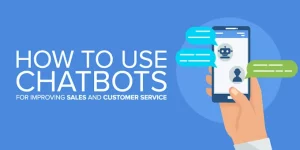Business
AI Chatbots Transforming Small Business Customer Support

Introduction
Small businesses often juggle many roles: answering phones, replying to emails, and helping customers online. Limited staff and long hours make it hard to give fast, consistent support. AI chatbots offer a smart solution. These conversational agents handle routine questions day and night, freeing teams to focus on complex tasks. In 2025, AI chatbots have become more natural and helpful than ever. They can understand intent, personalize replies, and even escalate issues to human agents when needed. This article explains how AI chatbots transform small business customer support. You will learn what AI chatbots are, their key benefits, how to choose and implement them, real-life examples, metrics to track, common pitfalls, and future trends. By the end, you will know how to leverage chatbots to boost satisfaction, cut costs, and grow your small business.
What is an AI Chatbot?
An AI chatbot is a software program that uses artificial intelligence to simulate human conversation. Unlike simple rule-based bots, AI chatbots use natural language processing to understand questions. They learn from past interactions to improve responses over time. You might see chat windows on websites or messaging apps where a bot greets you and asks how it can help. The bot can answer frequently asked questions, collect contact details, schedule appointments, and more. For tasks beyond its training, it transfers the chat to a human agent. AI chatbots run 24/7 without breaks, ensuring customers always receive an immediate reply.
How AI Chatbots Work
AI chatbots rely on two main technologies: natural language processing (NLP) and machine learning. NLP breaks down text or voice input into understandable parts. It identifies keywords, intent, and sentiment. Machine learning uses data from past chats to improve the bot’s accuracy. Over time, the system learns which replies solve customer issues fastest. Developers feed the chatbot with a knowledge base of product details, policies, and conversation scripts. As customers interact, the bot updates its models. Some chatbots also use AI to suggest answers to live agents, speeding up human responses.
Benefits of AI Chatbots for Small Businesses

Image by: Yandex.com
Small businesses gain many advantages by adding AI chatbots to their support toolkit.
24/7 Availability and Faster Response
Customers expect quick answers at any hour. A live agent can’t work all night, but a chatbot can. Instant replies reduce wait times and prevent drop-offs. Even if the bot can’t fully resolve an issue, it can gather information and let the customer know when an agent will follow up.
Cost Savings on Support
Hiring and training support staff is expensive. AI chatbots handle up to 80 percent of routine queries. This cuts labor costs and lets small teams focus on high-value tasks. With fewer agents needed for basic questions, businesses can scale support without scaling headcount.
Consistent and Accurate Information
Humans make typos and may give conflicting answers. A chatbot draws from a single knowledge base, ensuring consistent replies. Updates to product info or policies reflect instantly across all chats. This accuracy builds trust and reduces errors.
Lead Generation and Sales Support
Beyond service, chatbots can qualify leads by asking pre-set questions. They collect emails, phone numbers, and preferences. If a visitor expresses buying intent, the bot can hand off the lead to sales. Some chatbots even process simple orders or bookings directly in the chat window.
Improved Customer Satisfaction
Fast, reliable service drives satisfaction. Chatbots handle high volumes without burnout. Personalized greetings and context-aware suggestions make customers feel heard. When combined with human agents, the handoff is seamless, further boosting experience.
Types of AI Chatbots for Customer Support

Image by: Yandex.com
Small businesses can choose from several chatbot styles based on their needs.
Rule-Based Chatbots
These bots follow predefined scripts with if-then rules. They work well for simple FAQs and guided flows. Rule-based bots are easy to set up but lack deep understanding of complex language.
NLP-Powered Chatbots
NLP chatbots interpret free-form text. They match user intent to responses even if customers phrase questions differently. These bots require more training data but handle a wider range of queries.
Voice-Enabled Chatbots
Voice bots work on phone lines or smart speakers. They use speech recognition and AI to understand spoken questions. These chatbots make support more accessible for customers who prefer talking over typing.
Hybrid Chatbots
Hybrid models combine bot and human. The bot handles routine tasks. If it can’t answer, it seamlessly transfers the conversation to a live agent. This approach balances efficiency with human empathy.
How to Choose the Right Chatbot for Your Business

Image by: Yandex.com
Picking the right chatbot solution means matching its features to your goals and resources.
Define Your Use Cases
Start by listing the tasks you want to automate. Is it answering FAQs, booking appointments, or qualifying leads? Choose a chatbot type that excels in those areas.
Consider Your Budget and Technical Skills
Rule-based bots cost less and require minimal training. NLP bots cost more and need ongoing data input. Evaluate vendor pricing models—subscription versus pay-per-use—and factor in integration costs.
Look for Easy Integration
Select a chatbot that plugs into your existing platforms—website, Facebook Messenger, WhatsApp, and CRM. A unified system ensures no customer query falls through the cracks.
Evaluate Customization and Scalability
Your chatbot should adapt as your business grows. Check if you can update scripts, add new intents, and expand to new channels without major coding.
Test User Experience
Run pilot tests with real customers or employees. Gather feedback on response accuracy, speed, and conversation flow. A friendly, human-like tone often performs best.
Implementing an AI Chatbot: Step by Step

Image by: Yandex.com
Rolling out a chatbot involves planning, training, and monitoring.
Step 1: Map Customer Journeys
Identify the most common customer interactions: order status checks, product inquiries, or support requests. Map these paths to define how the chatbot should respond at each step.
Step 2: Build the Knowledge Base
Gather all FAQs, product details, policy notes, and contact info. Feed this data into the chatbot platform. Organize content clearly so the bot retrieves the correct answer.
Step 3: Train the AI Model
If using NLP, train the model by inputting example queries. Label intents and entities. The more diverse your examples, the better the bot handles real-life language.
Step 4: Set Up Escalation Rules
Decide when the chatbot should hand off to a human agent. For instance, after three failed attempts to answer or when a user requests live support. Configure alerts so agents can join chats immediately.
Step 5: Test and Iterate
Launch a beta version with internal or select customers. Monitor chat logs for misunderstandings and gaps. Refine scripts based on feedback. Repeat testing until performance meets your goals.
Step 6: Launch and Promote
Announce the new chatbot on your website, social media, and email newsletters. Encourage customers to try it for quick answers. Offer incentives like faster support or chatbot-exclusive tips.
Step 7: Monitor Metrics and Improve
Track metrics like resolution rate, customer satisfaction (CSAT), average response time, and deflection rate (percentage of queries handled by the bot). Use these insights to fine-tune the knowledge base and workflows.
Case Studies: Small Businesses Winning with Chatbots

Image by: Yandex.com
Real examples show how small companies reap big rewards.
Boutique E-Commerce Store
A handmade jewelry shop added a chatbot to answer sizing and shipping questions. Within six months, the bot handled 70 percent of support chats. Response times dropped from hours to seconds. Customer satisfaction rose by 25 percent, and sales increased by 15 percent as visitors felt more confident purchasing.
Local Service Provider
A landscaping business used a voice-enabled chatbot for appointment booking. Customers called after hours to schedule quotes. The bot captured customer info and offered next-day slots. This 24/7 booking feature boosted leads by 40 percent without extra staff.
Health and Wellness Coach
An online fitness coach deployed a chatbot on Facebook Messenger to share workout tips and collect client goals. The bot sent daily reminders and answered diet questions. Member engagement soared, and the coach added five new subscriptions per week from bot leads.
Table: Key Metrics for Chatbot Success
| Metric | Definition | Ideal Target for SMBs |
|---|---|---|
| Resolution Rate | % of queries resolved by the bot | 70–90% |
| Average Response Time | Seconds per reply | <5 seconds |
| Deflection Rate | % of total queries handled by the bot | 60–80% |
| Customer Satisfaction (CSAT) | Rating after chat session (1–5) | 4.0+ |
| Lead Conversion Rate | % of bot-qualified leads who buy | 10–20% |
Common Pitfalls and How to Avoid Them

Image by: Yandex.com
Even the best chatbots can struggle without proper setup and maintenance.
Poor Knowledge Base Quality
A bot only performs as well as its data. Keep FAQs updated. Review conversation logs weekly and add new questions and answers.
Overly Rigid Scripts
Rule-based bots may frustrate users when they can’t handle small variations in language. Mix in NLP capabilities or ensure scripts allow for simple rephrasings.
Lack of Human Escalation
Never lock users in an endless loop with the bot. Implement clear escalation paths. Include a “talk to agent” option at any time.
Ignoring User Feedback
Provide quick prompts like “Was this helpful?” after each answer. Analyze feedback and refine the bot’s responses regularly.
Future Trends in AI Chatbots for Small Business
AI chatbots will keep advancing and offering new possibilities.
Voice-first bots will become more common as smart speakers grow in popularity.
Generative AI will draft personalized emails and proposals directly from chat.
Emotion detection will let bots adjust tone and empathy based on user sentiment.
Multilingual support will expand, enabling global customer service without extra staff.
Deep integrations with CRM, inventory, and billing systems will streamline end-to-end workflows.
Conclusion
AI chatbots offer small businesses a powerful way to scale support, cut costs, and boost customer satisfaction. By automating routine questions and lead qualification, teams can focus on high-value tasks and complex issues. Key features like lead scoring, conversation analytics, and seamless human handoffs drive real results. To succeed, define your use cases, clean up your data, choose the right platform, and train your team. Monitor metrics, refine your bot, and stay ready to escalate as needed. With careful planning and ongoing maintenance, AI chatbots can transform your customer support into a strategic growth engine.
Call-to-Action
Ready to upgrade your support? Explore top AI chatbot platforms today and start your free trial. Deliver faster service and happier customers right away!
Business
3D Printing Gypsum Curing in Dubai: Strategies for Durability

Gypsum curing is a critical stage that determines long-term strength, dimensional stability and moisture resistance. Coastal environments in Dubai present specific challenges that include high humidity, salt-laden air and rapid temperature shifts between daytime heat and cooler nights. These conditions influence the hydration process and the crystal growth that occurs inside gypsum.
Because modern construction increasingly adopts 3d printing Dubai for façade elements and interior installations, curing strategies must consider how coastal factors affect printed layers. The goal is to achieve consistent curing without allowing moisture or salt to compromise final performance.

Understanding the Hydration Process in Gypsum
When gypsum is mixed with water, it forms a crystalline structure as it hydrates. The curing process allows these crystals to lock together and develop strength. If curing happens too quickly, internal stress may form, leading to cracks.
If curing happens too slowly in a humid environment, moisture may penetrate deeper and change the balance between hydration and drying.
Dubai’s coastal humidity delays evaporation and may allow water to stay trapped longer. This condition encourages slower crystal formation but increases the risk of salt entering the matrix. Therefore, curing must be carefully controlled to achieve complete hydration while maintaining environmental protection.
Challenges from Coastal Humidity and Salt Exposure
Coastal Dubai humidity carries micro salt particles that can enter fresh gypsum surfaces. Salt promotes internal crystal growth after curing, which may weaken the structure over time.
Another challenge comes from humidity variations between indoor cooling and outdoor heat. These rapid transitions can strain the freshly cured material.
When gypsum is printed in open coastal environments, humidity may prevent proper layer bonding and increase capillary absorption. Designers must use curing methods that control early moisture levels while preventing salt migration into the matrix.
Temperature Control During Initial Curing
Temperature has an important influence on curing speed. High temperatures speed up hydration, while low humidity speeds drying. However, Dubai coastal conditions provide the opposite combination of high temperature and high humidity.
This combination may accelerate some hydration processes while slowing evaporation. As a result, printed gypsum may cure unevenly. Temperature control devices are often used to stabilize curing zones.
For outdoor printing, shading and controlled airflow reduce overheating and maintain consistent moisture levels throughout the curing stage.
Humidity Management and Protective Enclosures
Protective curing enclosures help control humidity around printed components. These enclosures prevent direct exposure to coastal air during the early stages of curing. Temporary barriers such as curing tents or sealed wrappers block airborne salt and reduce humidity variation.
Controlled ventilation ensures that moisture gradually leaves the gypsum while allowing complete hydration inside the material. In many Dubai coastal printing sites, enclosed curing zones are part of standard procedure for exterior architectural components.
Use of Accelerators and Retarders for Coastal Conditions
Chemical additives known as accelerators and retarders help adjust curing speed depending on environmental conditions. Accelerators shorten curing time so that moisture leaves the system before excess humidity can enter.
Retarders slow hydration when printed elements require deeper bonding before final set. In coastal Dubai conditions, additives are selected very carefully because both slow and fast curing can cause structural issues.
Balanced formulas allow gypsum to hydrate sufficiently without absorbing additional moisture from the marine atmosphere.
Polymer and Latex Modification for Moisture Control
Polymer additives create internal films that regulate moisture migration during curing. These films help manage the relationship between hydration and evaporation.
Polymer modification also enhances early strength so printed layers resist humidity during the critical first hours. Latex additives improve internal bonding and reduce swelling when humidity is high. These enhancements allow gypsum to achieve a stable cure even when exposed to marine air.
Hydrophobic Surface Treatments During Curing
Some curing strategies apply hydrophobic coatings early in the curing cycle. These coatings temporarily shield the surface from coastal humidity and salt particles.
When applied during curing rather than after, they support controlled moisture release without allowing external moisture to penetrate. The coatings can be silicone-based or polymer-based depending on the finishing requirements.
Early treatments must remain breathable enough for hydration to complete while still blocking airborne salts.
Slow Curing for Structural Stability
A controlled slow cure improves crystal formation and reduces internal stress. However, slow curing in coastal humidity requires environmental controls to prevent water and salt from entering the matrix.
Controlled slow curing uses sheltered spaces, mild airflow and monitored temperature. Printed pieces may be rotated or re-positioned to encourage uniform drying across all layers. Slow curing strategies are usually used for high-detail architectural elements where dimensional accuracy matters most.
Accelerated Drying in Specific Printing Scenarios
Certain printed parts are cured using accelerated drying methods such as mild heating systems or dehumidifying chambers. These methods remove moisture quickly but safely.
Accelerated curing is useful for large outdoor elements exposed to coastal humidity immediately after printing. Dehumidifiers reduce ambient moisture and prevent salt-laden air from contacting the surface. Care must be taken to avoid rapid drying that may create shrinkage cracks or uneven curing.
Testing Procedures Designed for Coastal Dubai
Gypsum curing strategies are validated through laboratory tests that simulate coastal humidity, temperature cycles and salt spray exposure. Mechanical strength, dimensional stability and surface hardening are tested after full curing.
These tests confirm whether curing adjustments successfully protect printed elements under Dubai coastal conditions. Long-term performance studies examine how cured gypsum behaves after repeated humidity cycles and exposure to salt-laden air.
Conclusion
Gypsum curing near Dubai coastlines requires thoughtful control of temperature, humidity and salt exposure. Enclosures, additives, hydrophobic treatments, polymer modification and environmental control systems all contribute to reliable curing.
Because 3d printing is increasingly used for custom architectural elements, curing adjustments must protect early hydration and long-term performance.
With well-designed curing strategies, gypsum components remain durable, dimensionally stable and visually accurate even under demanding coastal conditions.
Art /Entertainment
Custom Jewelry at Careems: Crafting Meaningful Expressions

Discovering the Art of Custom Jewelry at Careems
This article explores why custom jewelry is becoming so popular, what makes Careems a leader in the industry, and how choosing personalized pieces can create lasting value across generations.

Why Custom Jewelry Matters More Than Ever
In the past, people often purchased jewelry as part of tradition—weddings, birthdays, cultural celebrations. While this still holds true, modern buyers look for something deeper: individuality.
Custom jewelry allows people to shape their own story through design, craftsmanship, and emotion. Instead of wearing what everyone else has, customers can collaborate with expert jewelers to bring a unique vision to life.
There are several reasons why custom jewelry has become a preferred choice:
1. Personal Expression
Custom pieces reflect personality. Whether it’s a ring designed around a memory, a necklace inspired by a loved one, or earrings crafted to match one’s style, customers can design exactly what they imagine.
2. Emotional Connection
A custom design often carries sentimental meaning. Engagement rings, wedding bands, or anniversary gifts created uniquely for someone make the moment more special and memorable.
3. Higher Craftsmanship Standards
When creating custom jewelry, expert jewelers spend more time perfecting each detail. This often results in better quality than mass-produced items.
4. Long-Term Value
Custom jewelry pieces can become heirlooms. Families pass them down through generations, giving them historical and emotional importance.
In Sri Lanka, where tradition blends beautifully with modern style, these reasons make custom jewelry a growing trend among young buyers, travelers, and couples alike.
Careems: A Heritage Jewelry Store With Timeless Craftsmanship
When discussing premium craftsmanship in Sri Lanka, Careems is a name that consistently stands out. Established generations ago, Careems is more than just another jewelry store it is a symbol of trust and artistry. Many locals and visitors recognize it as one of the country’s most respected jewelers.
Careems built its reputation through:
• Skilled artisans
Their craftsmen have decades of experience in goldsmithing, gem-setting, and design. Sri Lanka’s long history with gemstones, especially sapphires, gives Careems access to expert teams who understand the art deeply.
• High ethical standards
Customers value transparency when buying gold, diamonds, or Sri Lankan sapphires. Careems prioritizes authenticity and responsible sourcing, an essential factor in today’s jewelry market.
• Personal service
Unlike large commercial stores, Careems gives customers a personalized experience. Their consultants guide clients through every step, from choosing stones to approving final CAD designs.
• Elegance through simplicity
Careems is known for designs that are refined, balanced, and timeless rather than overly flashy. This subtle sophistication appeals to customers looking for long-lasting beauty.
These qualities make Careems a preferred destination for anyone seeking custom jewelry that blends tradition with modern elegance
The Custom Jewelry Experience at Careems
Creating custom jewelry can feel overwhelming at first, especially for buyers who don’t know much about gem quality or design. But Careems simplifies the process, making it enjoyable and educational.
Here’s how the experience often unfolds:
1. Initial Consultation
Customers meet with a designer or consultant to share their idea. It could be a sketch, a Pinterest photo, or even a simple description. Careems listens carefully to interpret the vision accurately.
2. Selecting Materials
Next comes choosing gemstones and metals. Careems provides expert guidance on Sri Lankan sapphires, diamonds, gold purity levels, and other materials. Customers learn about quality grades, colors, clarity, and pricing.
3. Design Visualization
Using modern design tools, Careems creates 3D models or sketches so customers can see what the final piece will look like. This stage allows changes, adjustments, and refinements.
4. Crafting the Piece
Once approved, the piece moves into production. Skilled craftsmen work with meticulous care, from shaping the metal to setting the gemstones. Every detail is handcrafted to perfection.
5. Final Delivery
The completed piece is polished, inspected, and presented beautifully. Many customers describe this moment as emotional — especially when it’s for a proposal, wedding, or family celebration.
This clear, supportive process is one reason why Careems remains a top jewelry store for personalized creations.
Why Customers Prefer Careems Over Other Jewelry Stores
There are many jewelry shops in Sri Lanka, but Careems continues to attract customers both locally and internationally. Several factors explain this consistent preference:
❖ Authenticity and Trust
Careems has decades of experience, and its reputation has remained strong throughout the years. Customers trust them with important purchases like engagement rings and wedding jewelry.
❖ Focus on Quality, Not Mass Production
While many stores push ready-made designs, Careems specializes in meaningful custom pieces crafted to last a lifetime.
❖ Heritage Meets Modern Technology
They combine traditional craftsmanship with modern tools like CAD design, creating a blend of precision and artistry.
❖ Strong Customer Relationships
Many families return to Careems for generations, which says a lot about the store’s commitment to service and satisfaction.
❖ International Appeal
Tourists visiting Sri Lanka often choose Careems for high-quality gemstones — especially Ceylon sapphires, which are globally famous.
The Future of Jewelry: Personal, Meaningful, and Custom-Made
As the world becomes more digital, customers still crave human connection and meaningful experiences. Jewelry shopping is no exception. The rise of custom jewelry shows that people want pieces that match their identity, values, and memories.
Careems recognizes this shift and continues to innovate while protecting its rich heritage. Whether it’s a simple pendant or a luxurious engagement ring, the store ensures every custom creation is crafted with passion and precision.
In the years ahead, the demand for personalization will only grow. And as more customers seek authenticity and emotional value, Careems is well positioned to remain one of Sri Lanka’s most trusted jewelry stores.
Business
Trade Data: Unlocking Global Trade Success with Trusted Partners

Finding Trusted Partners: The Role of Trade Data in Global Business
In the vast landscape of global commerce, one of the greatest challenges businesses face is identifying trustworthy partners. Even if you have an exceptional product or a solid business strategy, success often hinges on connecting with reliable buyers and sellers.
Without the right partners, your business journey can become slow, confusing, and stressful.

This is where it steps in as a crucial yet often overlooked ally. Operating quietly in the background, trade data enables you to uncover verified importers and exporters.
It’s not complex; it simply records who is buying, who is selling, and the dynamics of these transactions. Armed with this information, you can make informed decisions, steer clear of untrustworthy entities, and focus on building strong business relationships.
In this article, we’ll delve into how trade data simplifies the process of identifying international partners, using clear examples to illustrate its effectiveness.
Toward the end, we will introduce Siomex, a dependable source of trade data that provides clean and useful information for importers and exporters alike.
The Importance of Verified Partnerships
Consider this scenario: You have a product you want to export overseas. After browsing online, you stumble upon a potential buyer who reaches out with an enticing offer. Their communication seems friendly and their proposal appealing, but how can you determine if they’re genuine? Are they a reputable company? Will they pay on time?
Many businesses encounter similar dilemmas. Partnering with unverified entities can lead to delayed payments, incorrect orders, and even financial losses. This underscores the need to vet potential importers and exporters, and makes this process straightforward and secure.
Trade Data: Your Business Map
Think of trade data as a navigational map guiding you through the complexities of international trade. When embarking on a journey, a map directs you along the correct routes, helping you avoid pitfalls. Likewise, trade reveals the path to suitable business partners.
This map provides vital information, such as:
- The countries where specific products are in demand.
- The established players in your target market.
- How frequently these companies buy or sell.
- The volume of goods they handle.
- Connections they have with different countries.
By leveraging this basic yet comprehensive information, you can validate the legitimacy and activity level of potential buyers or sellers.
Discovering Verified Importers and Exporters with Data
1. Observe Real Buying and Selling Activities
Let’s say you are in the business of selling eco-friendly cotton bags, and your goal is to find a buyer in Europe. By accessing trade data, you can examine which companies have recently purchased cotton bags, how many they bought, and from whom. This allows you to bypass uncertain contacts and focus on actual buyers already engaged in the product market.
This approach is similar to peering into a store before stepping inside; if you notice customers actively shopping, you feel more confident about making a purchase.
2. Confirm the Existence of a Company
The internet is rife with deceptive companies promoting enticing offers. However, it allows you to investigate whether a company genuinely conducts business. If you find no record of their buying or selling activities, you can quickly deduce that the company may not be legitimate. This insight gives you the confidence to protect yourself from potentially harmful dealings.
3. Identify Experienced Buyers
Every seller prefers to work with buyers familiar with their product type. If you are marketing spices, you’ll be keen to collaborate with buyers who consistently engage with spice vendors. Trade data enables you to pinpoint who is actively trading in your product category, saving you time and allowing you to foster enduring relationships.
4. Understand Volume Requirements
Companies have varying purchasing habits—some buy bulk quantities while others order in smaller amounts. Trade data informs you of these patterns, enabling you to tailor your proposals accordingly.
For example:
- If a buyer typically orders 500 units per month but you cannot meet that demand, it might not be worth pursuing.
- Conversely, if another buyer usually orders 50 units and you can supply 500, you may be able to make a compelling offer that aligns with their needs.
Understanding the volume dynamics improves your chances of a successful transaction.
5. Know Their Operating Territories
If your goal is to export goods to the Middle East, trade data reveals which companies are consistently importing products from your country or neighboring regions. Partnering with these companies can streamline your export process since they are already acquainted with relevant regulations and timings.
Saving Time and Money with Trade Data
Without the insights offered by trade data, you could waste countless hours sifting through online information, sending emails, and making calls with minimal results. Many of these efforts may lead you nowhere.
Trade data allows you to focus exclusively on verified entities, significantly reducing wasted time while accelerating your growth.
Enhance Your Market Understanding
Beyond connecting you with potential partners, trade data provides insights into current market trends. You can identify which products are gaining traction, who is buying more in specific regions, and how demand shifts over time. This understanding assists in making strategic decisions for your business.
An Example for Clarity
Let’s consider Rohan, a candle maker in India looking for buyers in the United States. Despite spending days researching online, he struggles to find genuine leads. Many prospects respond, but Rohan is unsure of their legitimacy.
By acquiring trade data from a trustworthy provider like Siomex, Rohan uncovers crucial insights:
- Names of U.S. companies that have purchased handmade candles recently.
- Their buying patterns over recent months.
- Typical quantities they order.
- The vendors from whom they have previously purchased.
Equipped with this knowledge, Rohan can confidently reach out to these companies, knowing the potential buyers are active and familiar with the product. This simple action positions him to grow his business while reducing unnecessary risks.
Why Choose Siomex for Trade Data?
Siomex is committed to supporting importers and exporters by providing accurate and user-friendly trade data. Businesses rely on Siomex for its emphasis on accuracy and simplicity, ensuring that users can easily identify genuine buyers and sellers without confusion.
Here’s why Siomex stands out:
- Comprehensive information presented in an intuitive format.
- Data sourced from a variety of countries.
- Clear buyer and seller listings.
- Daily updates to keep you abreast of current market conditions.
- A straightforward dashboard that caters to beginners.
- A dedicated support team to assist you.
Whether you’re searching for new partners or laid plans for market entry, Siomex empowers you to make informed decisions swiftly and effectively.
Tips for Making the Most of Your Trade Data
To maximize the benefits of trade data, consider the following tips:
- Check Recent Activity: Focus on companies with the most recent transactions, indicating they are active in the market.
- Match Product and Quantity: Prioritize reaching out to companies that deal in your type of product and similar volume.
- Craft a Simple Introduction: Introduce yourself, your business, and the mutual benefits of a partnership concisely and warmly.
- Track Market Trends: Utilize trade data to monitor changes in demand for your product by region, allowing for timely adjustments in strategy.
- Opt for Trusted Sources: Choose reliable data providers like Siomex to ensure your search is effective and secure.
Final Thoughts
Accessing trade data simplifies the task of identifying trustworthy importers and exporters. It serves as a guide, steering you away from unverified companies while revealing genuine partners. In an ever-evolving business environment, where finding credible connections is essential, this data acts as your valuable ally.
Siomex is a key player in this space, offering clear and actionable. Many businesses utilize it to discover buyers, sellers, and new opportunities worldwide.
If you’re eager to trade confidently and expand your business, start leveraging trade data today. This invaluable tool will save you time, reduce stress, and propel your venture forward.
Frequently Asked Questions
What is trade data?
It encompasses fundamental information regarding the exchange of goods between countries, detailing who buys, who sells, what products are involved, and the frequency of these transactions.
How does trade data help in verifying importers and exporters?
It reflects the true activity levels of companies, revealing what they are buying, how much they purchase, and their sourcing countries. This visibility is vital in finding reliable partners.
Why should I use Siomex?
Siomex offers transparent, up-to-date, and easily digestible trade data, guiding you toward genuine buyers and sellers without confusion. Many businesses trust its reliability.
Can beginners utilize trade data?
Yes! With an intuitive platform like Siomex, beginners can access clean and understandable trade information.
Does trade data matter to small businesses?
Absolutely. Trade data enables small businesses to bypass time-consuming and risky searches, connecting them with verified global partners efficiently.
-
Business2 years ago
Cybersecurity Consulting Company SequelNet Provides Critical IT Support Services to Medical Billing Firm, Medical Optimum
-
Business2 years ago
Team Communication Software Transforms Operations at Finance Innovate
-
Business3 years ago
Project Management Tool Transforms Long Island Business
-
Business2 years ago
How Alleviate Poverty Utilized IPPBX’s All-in-One Solution to Transform Lives in New York City
-
health3 years ago
Breast Cancer: The Imperative Role of Mammograms in Screening and Early Detection
-
Sports3 years ago
Unstoppable Collaboration: D.C.’s Citi Open and Silicon Valley Classic Unite to Propel Women’s Tennis to New Heights
-
Art /Entertainment3 years ago
Embracing Renewal: Sizdabedar Celebrations Unite Iranians in New York’s Eisenhower Park
-
Finance3 years ago
The Benefits of Starting a Side Hustle for Financial Freedom






























